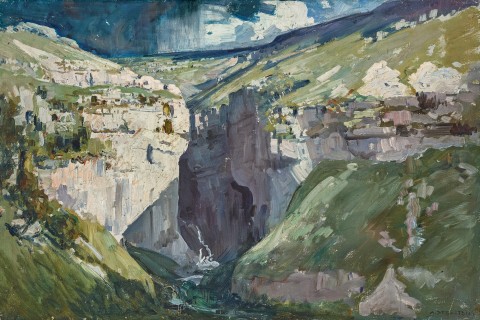GORDALE SCAR (SUNNY), 1910
ARTHUR STREETON
oil on canvas
50.5 x 76.0 cm
signed lower right: A. STREETON
Oliver Streeton, Melbourne
Norman Schureck, Sydney
James R. Lawson, Sydney, 27 – 28 March 1962, lot 48
Major Harold de Vahl Rubin, Brisbane (label attached verso)
Christie’s, Sydney, 2 October 1973, lot 50
Private collection, Sydney
Thence by descent
Private collection, Melbourne
Mr. Streeton’s Pictures, Victorian Artists’ Society, Melbourne, open 5 June 1914, cat.24 or 90 (both listed as ‘Goredale Scar’ [sic], 30” x 20”, 52 gns)
110 Years of Australian Art: an exhibition of the art of Australia – drawings, paintings, sculpture – since 1840, Farmers’ Blaxland Galleries, Sydney, September 1950, cat.29 (as 'Cordale Scar [sic]')
Norman Schureck Loan Exhibition, Art Gallery of New South Wales, Sydney, June 1958, cat. 85, illus. (as ‘Goredale Scar’ [sic])
A Very Private Collection, S.H. Ervin Gallery, The National Trust Centre, Sydney, 15 June – 15 July 1990, cat. 63, as 'Cordala Scar' [sic].
Colquhoun, A, ‘Mr. A. Streeton Exhibits: nature closely observed’, The Herald, Melbourne, 4 June 1914, p.10
‘Mr Arthur Streeton’s Pictures', The Age, Melbourne, 5 June 1914, p.12
‘Mr Arthur Streeton’s Pictures', The Leader, Melbourne, 6 June 1914, pp.51-52
Streeton, A., The Arthur Streeton Catalogue, Melbourne, 1935, cat. 442 (as ‘Goredale Scar’ [sic])
Gordale Scar is a 100-metre deep limestone chasm in the Yorkshire Dales. It has a significant connection to the poets and artists of the Romantic movement, including J. M. W. Turner who portrayed the Scar in a dramatic painting in c.1808. A decade later, William Wordsworth composed a sonnet, describing it as ‘terrific as the lair where the young lions couch’.1 With the Gordale Beck (river) at its heart forming divided waterfalls, the Scar also attracted the eye of Arthur Streeton, himself known for bold paintings of the Australian landscape, be it crashing waves, the cliffs of Sydney Harbour, or the eroded banks of a mighty river valley. In Gordale Scar (sunny), (1910), the chasm is pictured on a blustery day with the slightest threat of storm in the clouds.
Prior to his departure overseas in 1907, Streeton held successful exhibitions in Sydney and Melbourne, which allowed him the finance to travel through continental Europe. This included an extended stay in Venice where he ‘threw off his devotion to conscious art, and became absorbed again in truth of presentation.’2 Once in England, Streeton undertook a series of painting journeys with friends such as Tom Roberts, with whom he bicycled through Dorset in May 1909. In 1910, he undertook the famed loop walk in Yorkshire that includes Marnham Cove and Gordale Scar; though a recent scholarly catalogue claims the journey happened in September the previous year, possibly in the company of George Lambert.3 Streeton did large plein air studies at both sites, and the work offered here captures ‘the very spirit and essence ... in a kind of artistic shorthand, characterised by an amazing certainty of brush work.’4 In Gordale Scar (sunny), the drama of the chasm dominates the view with a final spill of one waterfall illuminating the void like a bolt of electricity. A clutch of stubbed yew trees and shrubs cling to the edge of the right-hand cliff, and the interplay of shadow and light recalls the muscularity of Streeton’s masterwork Fire’s On, 1891. On his return to Australia, Gordale Scar (sunny) and its companion Gordale Scar (grey) were included in the artist’s monumental exhibition (114 oils and 56 watercolours!) at the Victorian Artists’ Society; where the pair were singled out by critics for their ‘dazzling effect of cliff and verdure.’5 In particular, fellow artist-critic Alexander Colquhoun celebrated Streeton’s maintenance of ‘the charm and virility of the first stroke of the brush, a matter of more importance where light and purity of colour are a consideration.’6
Apart from its direct provenance to the Streeton family, Gordale Scar (sunny) had two other notable owners. The first, Norman Schureck, was a trustee of the Art Gallery of New South Wales who had a comprehensive collection of works by Australian artists, particularly William Dobell, who painted his portrait in 1942. The second was the eccentric grazier (Hon.) Major Harold de Vahl. His sprawling collection of works by such artists as Picasso, Degas, Renoir, Dobell and Streeton, filled his city residences, with the paintings ‘stacked face to face (alongside) live and stuffed exotic and domestic birds.’7 Gordale Scar (sunny) was purchased from the posthumous sale of the Major’s collection in 1973, and has remained in private hands ever since.
1. William Wordswoth, Gordale, 1818. Gordale is the correct spelling.
2. Lionel Lindsay, ‘Arthur Streeton’, in: Streeton, A., The Arthur Streeton Catalogue, Melbourne, 1935, p.16
3. See: Tunnicliffe, W. (ed.), Streeton, Art Gallery of New South Wales, Sydney, 2020, p.339
4. ‘Mr Arthur Streeton’s Exhibition. A further review’, The Age, Melbourne, 9 June 1914, p.9
5. ‘Mr Arthur Streeton’s Pictures’, The Age, Melbourne, 5 June 1914, p.12
6. Colquhoun, A, ‘Mr. A. Streeton Exhibits’: nature closely observed’, The Herald, Melbourne, 4 June 1914, p.10
7. Seear, L., ‘Rubin, Harold De Vahl (1899–1964)’, Australian Dictionary of Biography (online), https://adb.anu.edu.au/biography/rubin-harold-de-vahl-11581
ANDREW GAYNOR
